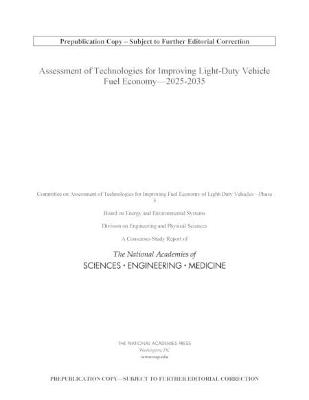
Assessment of Technologies for Improving Light-Duty Vehicle Fuel Economy—2025-2035
Seiten
2022
National Academies Press (Verlag)
978-0-309-37122-3 (ISBN)
National Academies Press (Verlag)
978-0-309-37122-3 (ISBN)
From daily commutes to cross-country road trips, millions of light-duty vehicles are on the road every day. The transportation sector is one of the United States' largest sources of greenhouse gas emissions, and fuel is an important cost for drivers. The period from 2025-2035 could bring the most fundamental transformation in the 100-plus year history of the automobile. Battery electric vehicle costs are likely to fall and reach parity with internal combustion engine vehicles. New generations of fuel cell vehicles will be produced. Connected and automated vehicle technologies will become more common, including likely deployment of some fully automated vehicles. These new categories of vehicles will for the first time assume a major portion of new vehicle sales, while internal combustion engine vehicles with improved powertrain, design, and aerodynamics will continue to be an important part of new vehicle sales and fuel economy improvement.
This study is a technical evaluation of the potential for internal combustion engine, hybrid, battery electric, fuel cell, nonpowertrain, and connected and automated vehicle technologies to contribute to efficiency in 2025-2035. In addition to making findings and recommendations related to technology cost and capabilities, Assessment of Technologies for Improving Light-Duty Vehicle Fuel Economy - 2025-2035 considers the impacts of changes in consumer behavior and regulatory regimes.
Table of Contents
Front Matter
Summary
1 Introduction
2 Fuel Economy, Greenhouse Gas Emissions, and Vehicle Efficiency Background
3 2025 Baseline of Vehicles
4 Internal Combustion Engine-Based Powertrain Technologies
5 Battery Electric Vehicles
6 Fuel Cell Electric Vehicles
7 Non-Powertrain Technologies
8 Connected and Automated Vehicles
9 Autonomous Vehicles
10 Energy and Emissions Impacts of Non-Petroleum Fuels in Light-Duty Vehicle Propulsion
11 Consumer Acceptance and Market Response to Standards
12 Regulatory Structure and Flexibilities
13 Emergent Findings, Recommendations, and Future Policy Scenarios for Continued Reduction in Energy Use and Emissions of Light-Duty Vehicles
Appendixes
Appendix A: Committee Biographical Information
Appendix B: Disclosure of Conflicts of Interest
Appendix C: Committee Activities
Appendix D: Acronyms
Appendix E: Center for Automotive Research Commissioned Study
This study is a technical evaluation of the potential for internal combustion engine, hybrid, battery electric, fuel cell, nonpowertrain, and connected and automated vehicle technologies to contribute to efficiency in 2025-2035. In addition to making findings and recommendations related to technology cost and capabilities, Assessment of Technologies for Improving Light-Duty Vehicle Fuel Economy - 2025-2035 considers the impacts of changes in consumer behavior and regulatory regimes.
Table of Contents
Front Matter
Summary
1 Introduction
2 Fuel Economy, Greenhouse Gas Emissions, and Vehicle Efficiency Background
3 2025 Baseline of Vehicles
4 Internal Combustion Engine-Based Powertrain Technologies
5 Battery Electric Vehicles
6 Fuel Cell Electric Vehicles
7 Non-Powertrain Technologies
8 Connected and Automated Vehicles
9 Autonomous Vehicles
10 Energy and Emissions Impacts of Non-Petroleum Fuels in Light-Duty Vehicle Propulsion
11 Consumer Acceptance and Market Response to Standards
12 Regulatory Structure and Flexibilities
13 Emergent Findings, Recommendations, and Future Policy Scenarios for Continued Reduction in Energy Use and Emissions of Light-Duty Vehicles
Appendixes
Appendix A: Committee Biographical Information
Appendix B: Disclosure of Conflicts of Interest
Appendix C: Committee Activities
Appendix D: Acronyms
Appendix E: Center for Automotive Research Commissioned Study
| Erscheinungsdatum | 04.01.2022 |
|---|---|
| Verlagsort | Washington |
| Sprache | englisch |
| Maße | 216 x 279 mm |
| Themenwelt | Naturwissenschaften ► Biologie ► Ökologie / Naturschutz |
| Technik | |
| ISBN-10 | 0-309-37122-8 / 0309371228 |
| ISBN-13 | 978-0-309-37122-3 / 9780309371223 |
| Zustand | Neuware |
| Haben Sie eine Frage zum Produkt? |
Mehr entdecken
aus dem Bereich
aus dem Bereich


